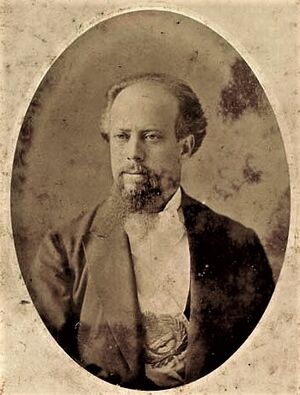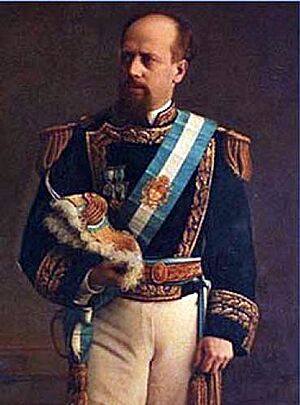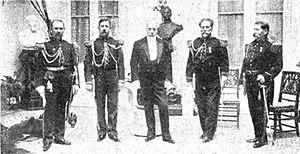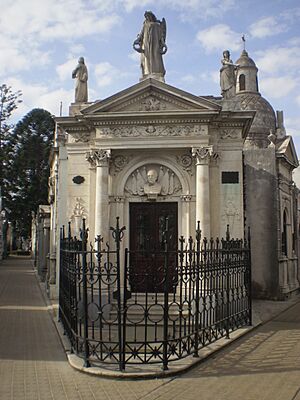Julio Argentino Roca facts for kids
Quick facts for kids
Julio Argentino Roca
|
|
|---|---|
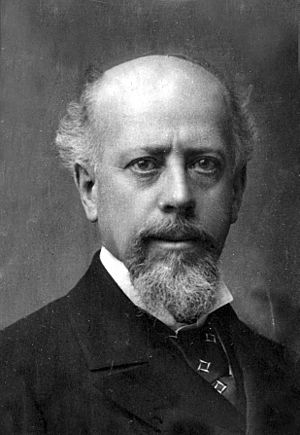 |
|
| President of Argentina | |
| In office October 12, 1898 – October 11, 1904 |
|
| Vice President | Norberto Quirno Costa |
| Preceded by | José E. Uriburu |
| Succeeded by | Manuel Quintana |
| In office October 12, 1880 – October 11, 1886 |
|
| Vice President | Francisco Bernabé Madero |
| Preceded by | Miguel Ángel Juárez Celman |
| Succeeded by | Nicolás Avellaneda |
| Minister of the Interior | |
| In office August 6, 1890 – May 1, 1891 |
|
| President | Carlos Pellegrini |
| Preceded by | Salustiano Zavalía |
| Succeeded by | José Vicente Zapata |
| Minister of War and the Navy | |
| In office January 4, 1878 – October 9, 1879 |
|
| President | Nicolás Avellaneda |
| Preceded by | Adolfo Alsina |
| Succeeded by | Carlos Pellegrini |
| Personal details | |
| Born | July 17, 1843 San Miguel de Tucumán, Argentina |
| Died | October 19, 1914 (aged 71) Buenos Aires, Argentina |
| Resting place | La Recoleta Cemetery |
| Political party | National Autonomist |
| Spouse | Clara Funes |
| Children | Julio Pascual Roca Alejandro Roca Elisa Roca María Marcela Roca Clara Roca Agustina Roca Josefina Roca Elena Roca |
| Parents | José Segundo Roca Agustina Paz |
| Relatives | Marcos Paz (uncle) |
| Signature | |
| Military service | |
| Allegiance | (until-1861) |
| Branch/service | |
| Years of service | 1856-1880 |
| Rank | |
| Battles/wars | Battle of Cepeda Battle of Pavón Battle of Lomas Blancas Battle of Las Playas Siege of Uruguaiana Battle of Yatay Battle of Tuyutí Battle of Curupayty Battle of San Ignacio Battle of Pastos Grandes Battle of Ñaembé Battle of Santa Rosa |
Julio Argentino Roca (born July 17, 1843 – died October 19, 1914) was an important army general and a leader in Argentina. He served as President of Argentina two times: from 1880 to 1886 and again from 1898 to 1904. Roca is known for leading the Conquest of the Desert. This was a series of military campaigns against the native communities of Patagonia. These campaigns had a very harsh impact on the native communities.
During his time as president, Argentina saw many big changes. There were major projects like building railroads and port facilities. More money came from other countries, and many people moved to Argentina from Europe. The country's farms and ranches grew a lot. Also, new laws were passed that made the government stronger and less controlled by the Church.
Roca also focused on foreign policy. He worked to clearly define Argentina's borders with Chile. In 1881, Argentina gained more land through a treaty with Chile.
Contents
Early Life and Military Career
Julio Roca was born in 1843 in San Miguel de Tucumán. This city is in northwestern Argentina. He came from a well-known local family. He finished school at the National College in Concepción del Uruguay.
When he was almost 15, Roca joined the army on March 19, 1858. As a young officer, he fought in conflicts between Buenos Aires and other provinces. He also fought in the Paraguayan War (1865-1870). Roca became a colonel during a revolt in Entre Ríos. Later, President Nicolás Avellaneda made him a General. This happened after Roca led loyal forces to victory in the Battle of Santa Rosa. Roca believed the army could help unite Argentina. His time in the army helped him understand the country better.
Beginning His Political Journey
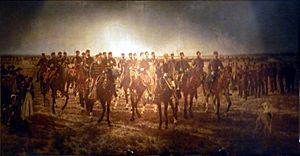
In 1878, during President Avellaneda's term, Roca became the Minister of War. His main job was to plan a campaign to solve the "frontier problem." Before this, native groups often raided settlements, taking animals and people. Roca's plan was different from his predecessor, Adolfo Alsina. Alsina had built a ditch and forts to protect the border.
Roca believed the only way to stop these raids was to take control of all the land up to the Río Negro river. This campaign was called the Conquest of the Desert. Its goal was to "extinguish, subdue or expel" the native people living there. He started the campaign against the Ranqueles people. This led to a large amount of land (about 35% of Argentina's territory) being taken from native groups. This land conquest also helped Argentina's position against Chile.
Roca planned a large attack with 6,000 cavalry soldiers. They moved from different cities in 1878 and 1879. Official records show that about 1,313 native people were killed. Around 15,000 were taken prisoner. Many European hostages were also freed.
Roca's First Presidency (1880–1886)
In 1879, Roca became a very important leader in the National Autonomous Party. He was suggested as a candidate for president. He quickly gained support from most of Argentina's governors. In the April 11 elections, Roca won by a large margin. On June 13, he was officially elected President.
However, a revolution started in Buenos Aires against Roca's victory. Fighting began on June 17 and ended on June 25. This conflict, known as the revolution of 1880, caused 3,000 deaths. Just before Roca became president, Buenos Aires was made the federal capital.
During his first term, Roca passed "laicist laws." These laws moved many tasks from the Church to the government. For example, he created the Registro Civil, which recorded all births, deaths, and marriages. President Roca also made primary education free by taking control of schools run by the Church. This caused problems with the Vatican. Roca's presidency was a time of fast economic growth. This was helped by many European immigrants, new railways, and a boom in farm exports. In May 1886, someone tried to assassinate Roca, but they failed.
Continuing His Political Influence
Roca chose Juárez Celman, his brother-in-law, to be his successor. But Celman later distanced himself from Roca. Celman's government faced problems due to a financial crisis and claims of corruption.
Roca did not join the 1890 revolution against Celman. This revolution was started by Leandro N. Alem and Bartolomé Mitre. However, Roca was happy that Celman's power weakened.
After his first presidency, Roca remained important in politics. He became a senator and served as Minister of the Interior. This was under President Carlos Pellegrini. When President Luis Sáenz Peña resigned in 1895, José Evaristo Uriburu took over. Roca was President of the Senate at that time. Because of this, Roca temporarily served as President from October 28, 1895, to February 8, 1896, while Uriburu was ill.
Roca's Second Presidency (1898–1904)
In mid-1897, Roca was again put forward as a presidential candidate. He had no strong opponents. He began his second full term as president on October 12, 1898. During this time, the Ley de Residencia (Law of Residence) was passed. This law allowed the government to expel some trade union leaders. These leaders were often non-citizens who were anarchists or socialists. The government saw them as dangerous to Argentina.
In 1901, military service became mandatory. A border disagreement with Chile was also resolved in 1902. Luis Drago, Roca's foreign minister, created the Drago Doctrine in 1902. This doctrine stated that foreign countries could not use military force to collect debts from American nations. Argentina's foreign debt grew during this period, but the economy continued to expand. Roca was not able to keep his strong political control. He also could not easily choose his successor. Roca's second term ended in 1904. It is often seen as less successful than his first.
Later Years and Legacy
In 1912, Roca was appointed as a special ambassador to Brazil. This was by President Roque Sáenz Peña. Roca returned to Argentina in 1914. He died in Buenos Aires on October 19, 1914. He was buried in La Recoleta Cemetery in Buenos Aires.
His son, Julio Argentino Roca, Jr., later became Vice-President of Argentina from 1932 to 1938.
Roca's Place in History
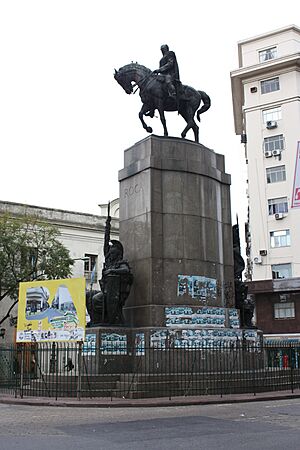
Roca's ideas are linked to the concept of a "possible republic." This idea suggested a government with many freedoms for citizens and businesses. However, political power would be held by a small group of leaders. This "possible republic" was meant to lead to a truly democratic republic later. This politically conservative approach caused disagreements. Even some members of his own group, the Generation of '80, opposed it.
For much of the 20th century, Roca was seen as a key leader who helped build modern Argentina. Many places across the country are named after him. These include cities, towns, streets, and railway lines. For example, there is the city of General Roca and the General Roca Department. In Buenos Aires, a major road and a railway line are named after him. A statue of him was also built in 1941.
In recent years, people have started to look at Roca's role in history differently. His involvement in the Conquest of the Desert is especially debated. Some groups believe he committed terrible acts against the native Argentines. Because of this, some people have suggested removing Roca's name from places that honor him.
See also
 In Spanish: Julio Argentino Roca para niños
In Spanish: Julio Argentino Roca para niños


